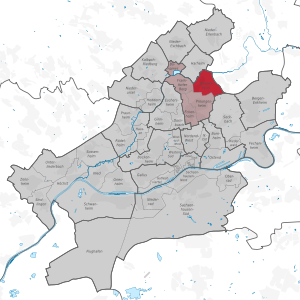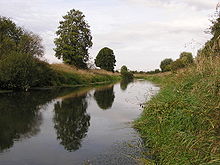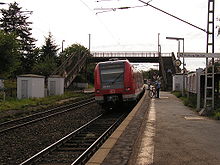Frankfurt-Berkersheim
|
Berkersheim 32nd district of Frankfurt am Main |
|
|---|---|
| Coordinates | 50 ° 10 '20 " N , 8 ° 41' 51" E |
| surface | 3.185 km² |
| Residents | 3791 (Dec. 31, 2019) |
| Population density | 1190 inhabitants / km² |
| Post Code | 60435 |
| prefix | 069 |
| Website | www.frankfurt.de |
| structure | |
| District | 10 - north-east |
| Townships |
|
| Transport links | |
| Train | S6 |
| bus | 25 39 66 n4 |
| Source: Statistics currently 03/2020. Residents with main residence in Frankfurt am Main. Retrieved April 8, 2020 . | |
Berkersheim has been a district of Frankfurt am Main in the northeast of the city since April 1, 1910 .
Berkersheim is Frankfurt's third smallest district after the airport and station district with 3,791 inhabitants. Its rather village character is very atypical for the big city .
Geographical location
Berkersheim is located on the northern slope of the Berger Ridge , the highest point of which is the Lohrberg , and extends to the Niddatal , where it is above a knee of the Nidda, about 7 km northeast of the city center and in the Frankfurt green belt . Since the construction of the Main-Weser Railway in the middle of the 19th century, the railway line has moved between the village and Niddatal.
There are many orchards on the Berger Ridge , especially apple trees, from whose juice the regional specialty, apple wine , is made. In Berkersheim there is also the Azur spring , whose spring water is bottled and sold as mineral water .
Berkersheim borders the Frankfurt districts of Bonames , Frankfurter Berg , Preungesheim , including Frankfurter Bogen , and Harheim and, to the east, the Bad Vilbel district of Heilsberg .
history
prehistory
The Berkersheim district was already settled in prehistoric times. In the first century AD it was part of the Roman city of Nida . This was ended by the Limes Falls and the withdrawal of the border between the Roman Empire and the Rhine in the second half of the 3rd century.
middle Ages
The oldest surviving mention of Berkersheim comes from 795: “ Berchgisisheim im Niddagau”. The name could be derived from a local founder, a Franconian , called Berthgisil, which means “magnificent Junker”. From the 15th century, the residents of Berkersheim enjoyed castle rights in the city of Frankfurt am Main: they were allowed to withdraw behind the Frankfurt city walls in case of danger. Ecclesiastically the village belonged to the parish Preungesheim . The middle church authority was the archdeaconate of the provost of St. Peter in Mainz , deanery Eschborn .
Historical forms of name were:
- Berchgisisheim (795)
- Berahtgisesheim (9th century)
- Berkirsheim (1280)
Originally Berkersheim was part of an extensive imperial estate , the Bornheimerberg Office , which was given to the Lords of Hanau as a pledge from 1320 and as a fief from 1434 . Various German rulers pledged the Bornheimerberg - and thus also Berkersheim - as well as rights to this territory in the 14th and early 15th centuries, but both to Hanau and to the imperial city of Frankfurt . This contradicting behavior naturally led to a dispute, especially since Frankfurt saw itself “surrounded” by Hanau territory. All attempts by Frankfurt to prevent this failed. So in 1481 a settlement was finally reached. Frankfurt received three villages of the office exclusively, Hanau kept the rest. Berkersheim finally came to the County of Hanau-Munzenberg . The Counts of Hanau were then able to convert the imperial fief into property in 1485. The lords and counts of Hanau passed the village on to the rogues of Bergen as a fief . The Teutonic Order , the Counts of Solms and the Falkenstein and Kronberg families also had property and rights here.
Modern times
In the middle of the 16th century, the Reformation took hold in the county of Hanau-Münzenberg, initially in its Lutheran form. In a "second Reformation", the denomination of the county was changed again: From 1597 Count Philipp Ludwig II pursued a decidedly reformed church policy. He made use of the Jus reformandi , his right as sovereign to determine the denomination of his subjects, and largely enforced the Reformed Confession as binding for the county.
After the death of the last Hanau count, Johann Reinhard III. , In 1736, Landgrave Friedrich I of Hessen-Kassel inherited the County of Hanau-Münzenberg and thus also the Bornheimerberg and Berkersheim on the basis of an inheritance contract from 1643.
During the Napoleonic period, Berkersheim was under French military administration from 1806 to 1810 and then from 1810 to 1813 it belonged to the Grand Duchy of Frankfurt , Hanau Department . Then it fell back to Hessen-Kassel, now called " Electorate of Hesse ". A fundamental administrative reform took place here in 1821: The Bornheimerberg was added to the newly formed Hanau district. In 1886 Berkersheim was assigned to the Frankfurt district and incorporated into the city of Frankfurt on April 1, 1910. In return, Berkersheim received a school building that is still in use today.
Population development
- 1632: 14 households
- 1783: 35 households with 162 people
- 1834: 234 inhabitants
- 1840: 279 inhabitants
- 1846: 284 inhabitants
- 1852: 313 inhabitants
- 1858: 321 inhabitants
- 1864: 368 inhabitants
- 1871: 347 inhabitants
- 1875: 361 inhabitants
- 1885: 361 inhabitants
- 1895: 368 inhabitants
- 1905: 399 inhabitants
Infrastructure
traffic
In 1850 Berkersheim received a rail connection through the Main-Weser-Bahn , which runs northwest of the district along the Nidda from Frankfurt Central Station via Friedberg to Kassel , and its own stopping point . Only S-Bahn trains - line S6 of the Rhein-Main transport association - stop here today . To the north of this is one of the few level crossings with the same rails in Frankfurt, which is to be replaced by an underpass when the line is expanded.
Several bus routes operated by the Frankfurt local transport company traffiQ connect Berkersheim to all of the surrounding districts:
- Line 25 to Nieder-Erlenbach via Harheim . Line 25 is special: Due to the low load-bearing capacity of the Niddabrücke at Harheimer Stadtweg , which is located on the route to Harheim in Berkersheimer Bahnstraße, it is the only bus line in the city that only has minibuses with a maximum capacity of 27 - and seats can be used.
- Line 27 to Preungesheim or Nieder-Eschbach via Bonames .
- Line 39 to Ginnheim via Preungesheim and Dornbusch .
- Line 66 to Eschersheim .
- Individual buses on line 63 to Frankfurt-Preungesheim via Am Neuenberg (Berkersheim)
- as well as the night bus line n4 to Konstablerwache on weekends .
Line 13 of the Frankfurt am Main tram also ran into the district until 1978 .
Berkersheim is surrounded in the south and east by the federal highway 661 and the federal highway 3 , but has no separate junction to these as a city highway.
school
- Berkersheim School (primary school)
Sights and cultural monuments
- Michaelis Church, built in 1766
- The memorial in memory of the victims of the First World War
- The view over the entire valley to the Taunus
Culture and leisure
In November 2011 the curtain of the independent theater " Theater Lempenfieber " rose for the first time in the historic hall of the traditional restaurant "Zum Lemp". The program primarily offers in-house productions with professional actors under the direction of Sven Eric Panitz and Sabine Koch in the field of comedy and cabaret.
Celebrations and events
- The horse show takes place annually on the first of May and the first weekend in September. It is organized by the Niddatal Riding and Driving Association.
- The Berkersheimer Curb, which was held for the 244th time in 2010, is celebrated annually on the last weekend in September. It is known beyond the borders of Frankfurt.
- The Berkehrsheimer Christmas market takes place every two years around the Berkersheimer church.
societies
- Berkersheimer Kerbeverein
- Citizens' Association Berkersheim
- Fire department in Berkersheim: Voluntary fire department Frankfurt am Main-Berkersheim
- Youth fire department Frankfurt am Main Berkersheim
- Football club in Berkersheim: FV-Berkersheim 1974
- Sports club in Berkersheim: TSV-Berkersheim 1910
- Berkersheim riding club
- Niddertal riding and driving club
- Musical-KIDS eV
Personalities
- Hanno Hahn (1922–1960), art historian and the only son of Nobel Prize laureate and Frankfurt honorary citizen Otto Hahn (1879–1968), lived as a student with his wife Ilse Hahn, b. Pletz (1920–1960) and son Dietrich from 1946 to 1952 in the house of his in-laws Margarethe and Arthur Pletz (1890–1975), who was the head of the Berkersheim School until 1955.
- Reinhard Goerdeler (1922–1996), lawyer and auditor, founder of KPMG , lived in Berkersheim since 1962
- Ernst Achilles (1929–1999), director of the fire department of the city of Frankfurt am Main and thus head of the Frankfurt fire department, lived with his family in Berkersheim.
literature
- Hans-Jürgen Becker: The court Bornheimer Berg . In: Tradition, Preservation and Design in Legal History Research, 1993, pp. 1–21.
- Gerhard Kleinfeldt u. Hans Weirich: The medieval church organization in the Upper Hesse-Nassau area = writings of the Institute for historical regional studies of Hesse and Nassau 16. 1937, ND 1984, p. 74.
- Anette Löffler: The Lords and Counts of Falkenstein (Taunus): Studies on territorial and property history, on imperial political position and on the genealogy of a leading ministerial family; 1255-1418. (Sources and research on Hessian history 99), Darmstadt 1994, vol. 1 p. 226f. ISBN 3-88443-188-9
- Heinrich Reimer: Historical local dictionary for Kurhessen . Marburg 1926, p. 38f.
- Heinz Schomann u. a .: Monument topography city of Frankfurt am Main . Braunschweig 1986, p. 414ff.
- Fred Schwind : The "Grafschaft" Bornheimer Berg and the royal people of the Frankfurt Treasury. In: Hessisches Jahrbuch für Landesgeschichte 14 (1964), pp. 1–21.
Web links
- "Berkersheim, City of Frankfurt am Main". Historical local dictionary for Hessen. In: Landesgeschichtliches Informationssystem Hessen (LAGIS).
- Literature about Frankfurt-Berkersheim in the Hessian Bibliography
- My district - my home on YouTube
Individual evidence
- ↑ Codex Laureshamensis Bd. 3 No. 3400 = Heinrich Reimer: Hessisches Urkundenbuch. Section 2, document book on the history of the Lords of Hanau and the former province of Hanau. Vol. 1. 767-1300. Publications from the Royal Prussian State Archives, Hirzel, Leipzig 1891 No. 11.
- ↑ City of Frankfurt / M., Office for Multicultural Affairs, so-called "district analysis Preungesheim" , published in December 2014, PDF final version from January 19, 2015; Accessed June 24, 2017






